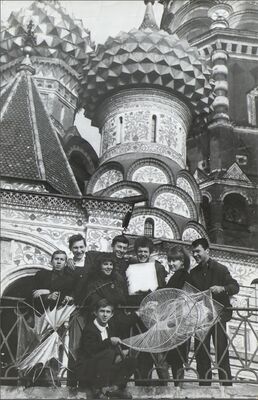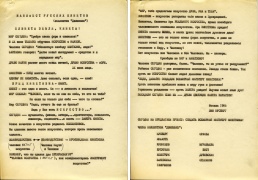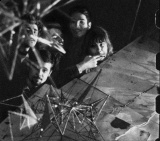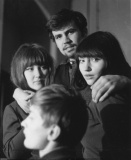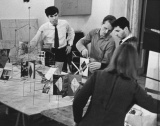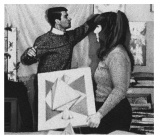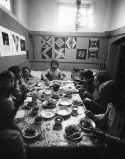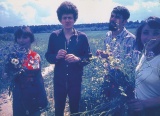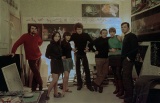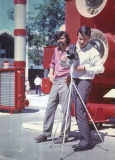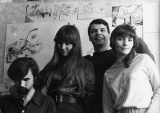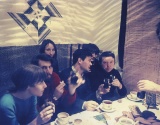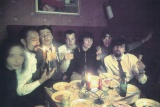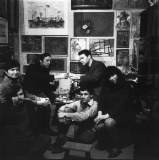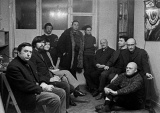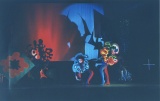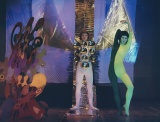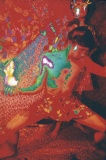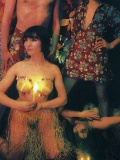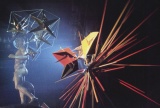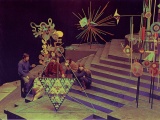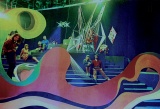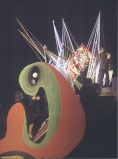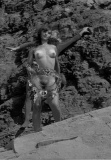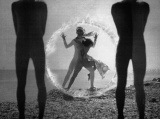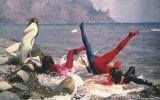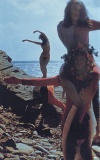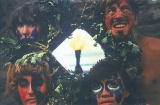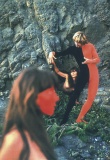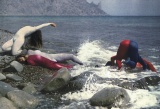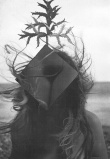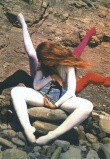Difference between revisions of "Dvizhenie"
| Line 1: | Line 1: | ||
[[Image:Dvizheniye.jpg|thumb|258px|]] | [[Image:Dvizheniye.jpg|thumb|258px|]] | ||
| − | [[Image: | + | [[Image:Dvizheniye_1966_Manifest_russkikh_kinetov.jpg|thumb|258px|''Manifest russkikh kinetov'', 1966.]] |
| − | ''' | + | '''Dvizhenie [Движение, Movement]''' was founded by [[Lev Nussberg|Lev V. Nussberg]] in [[1962]] as a group of young artists, primarily students at the art school affiliated with the Surikov Institute in [[Moscow]]. Its activities ranged from early, static works in painting and sculpture to kinetic constructions, performance, installations and projects related to urban planning. The group ceased to exist around 1978. |
==History and work== | ==History and work== | ||
Besides Lev Nusberg, the first members were [[Mikhail Dorokhov]], [[Francisco Infante|Francisco Infante-Arana]], [[Viacheslav Koleichuk]], [[Anatolij Krivchikov]], [[Viacheslav Scherbakov]], [[Viktor Stepanov]], and [[Rimma Zanevskaya]]. Later, [[Vladimir Galkin]], [[Juri Lopakov]], and others joined the group. From around 1966, [[Vladimir Akulinin]], [[Galina Bitt]], [[Tatiana Bystrova]], [[Alexander Grigorjev]], and [[Natalia Prokuratova]] were also members. The group was active on both an artistic and a theoretical level (producing manifestos, scripts and articles as well as artworks), and followed three principles: movement, synthesis, symmetry. The group's manifesto ''Манифест русских кинетов'' was written by Nusberg in 1966. | Besides Lev Nusberg, the first members were [[Mikhail Dorokhov]], [[Francisco Infante|Francisco Infante-Arana]], [[Viacheslav Koleichuk]], [[Anatolij Krivchikov]], [[Viacheslav Scherbakov]], [[Viktor Stepanov]], and [[Rimma Zanevskaya]]. Later, [[Vladimir Galkin]], [[Juri Lopakov]], and others joined the group. From around 1966, [[Vladimir Akulinin]], [[Galina Bitt]], [[Tatiana Bystrova]], [[Alexander Grigorjev]], and [[Natalia Prokuratova]] were also members. The group was active on both an artistic and a theoretical level (producing manifestos, scripts and articles as well as artworks), and followed three principles: movement, synthesis, symmetry. The group's manifesto ''Манифест русских кинетов'' was written by Nusberg in 1966. | ||
| − | In the mid- to late-1960s, the group turned from the suprematist and constructivist systems to more synthetic environments, or “artificial spaces,” which became | + | In the mid- to late-1960s, the group turned from the suprematist and constructivist systems to more synthetic environments, or “artificial spaces,” which became Dvizhenie’s main focus for the duration of its history. These took the form of functional design (eg. urban designs celebrating the 50th anniversary of the October Revolution in 1966 in Leningrad) and interior design, and outdoor performance (e.g. the ''Galaxy Kinetic Complex'' in 1967). |
Infante and Koleichuk left the group in the late 1960s. In 1976, Nussberg with part of the group emigrated to France and Germany, and after a few shows it finally broke up in connection to Nussberg's move to the United States in 1980. | Infante and Koleichuk left the group in the late 1960s. In 1976, Nussberg with part of the group emigrated to France and Germany, and after a few shows it finally broke up in connection to Nussberg's move to the United States in 1980. | ||
| − | ; Ekaterina Dyogot on | + | ; Ekaterina Dyogot on Dvizhenie |
"Nusberg tested out constructivist principles, while Infante engaged and explored the influence of [[Naum Gabo]] and [[Kazimir Malevich]] (hence his utopian, "supreme" projects, such as a skyscape remade along geometric lines). The collective proclaimed kinetic art meant for mass, ecstatic viewing, and created in an urban setting various synthetic wonders, with flashing lights, transparent plastics, screens, mirrors, smoke, and noise pouring out of loudspeakers. For the most part, this ideological design remained utopian, unhindered by the authorities. "The Movement"'s "live machines" continued El Lissitzky's later illusionist project, first by aspiring to hyper-individualism, but also in their critique of "dry" and "one-sided" geometry. Quite predictably, these artists rejected Western kineticism as too individualistic and its construction as moribund. The collective performances directed by Nusberg essentially appealed to the senses and sexuality -- reliable antidotes to geometry. The group dissolved after Nusberg emigrated to the United States; beginning in the 1970s, Infante worked independently, creating conceptual photographs of artificial objects in nature." [http://www.unlv.edu/centers/cdclv/archives/nc2/degot_art.html (source)] | "Nusberg tested out constructivist principles, while Infante engaged and explored the influence of [[Naum Gabo]] and [[Kazimir Malevich]] (hence his utopian, "supreme" projects, such as a skyscape remade along geometric lines). The collective proclaimed kinetic art meant for mass, ecstatic viewing, and created in an urban setting various synthetic wonders, with flashing lights, transparent plastics, screens, mirrors, smoke, and noise pouring out of loudspeakers. For the most part, this ideological design remained utopian, unhindered by the authorities. "The Movement"'s "live machines" continued El Lissitzky's later illusionist project, first by aspiring to hyper-individualism, but also in their critique of "dry" and "one-sided" geometry. Quite predictably, these artists rejected Western kineticism as too individualistic and its construction as moribund. The collective performances directed by Nusberg essentially appealed to the senses and sexuality -- reliable antidotes to geometry. The group dissolved after Nusberg emigrated to the United States; beginning in the 1970s, Infante worked independently, creating conceptual photographs of artificial objects in nature." [http://www.unlv.edu/centers/cdclv/archives/nc2/degot_art.html (source)] | ||
| − | ; Margareta Tillberg on | + | ; Margareta Tillberg on Dvizhenie |
"Dvizhenie was the first art group in the Soviet Union that worked with cybernetics. In addition to practicing artists, the group cooperated with actors, musicians, chemists, engineers in radio-electronic and light-technology, psychologists, architects, physicists, poets and performing dancers. The text accompanying their exhibition at the Palace of Culture of the Kurchatov Institute for Nuclear Research stressed the necessity of contiguity between art and science. In future cooperation between art and technology, “art is not to be limited to ornamentation, but to be inculcated in the production processes”. The notion of the participation in the “intensive rhythm of life” as one important task – is reminiscent of a slogan from the 1920s.<br> The cybernetic art of Dvizhenie has the form of kinetic light-colour-sound environments with “life-transforming” content. In 1967 their ''Cyberevents'' was shown in the engineering block of the Peter and Paul fortress in Leningrad, followed by ''Little Eagle'', a cybernetics pioneer game-amusement camp in [[Odessa]], and ''Cybertheater''. The ''Artificial Bio-Kinetic Environment'' from 1969, was a utopian virtual reality project presenting a future city of 35-40 million people. Paradoxically enough, Dvizhenie’s members were able to move in the circles both of the extremely official (propaganda produced for international trade shows, military and space research, design for control rooms at airports and big industries) and the in-official (free jazz, long hair, drugs, existentialism and Hemingway) - that the people interested in cybernetics, new technology, design, art, bionic-architecture and future urbanism and city planning frequented. <br>Dvizhenie was the first group in the Soviet Union that succeeded to produce big exhibitions “without content” from the point of view of Socialist Realism ideology. " [http://www.mediaarthistory.org/replace/replacearchives/tillberg_abstract.htm (source)] | "Dvizhenie was the first art group in the Soviet Union that worked with cybernetics. In addition to practicing artists, the group cooperated with actors, musicians, chemists, engineers in radio-electronic and light-technology, psychologists, architects, physicists, poets and performing dancers. The text accompanying their exhibition at the Palace of Culture of the Kurchatov Institute for Nuclear Research stressed the necessity of contiguity between art and science. In future cooperation between art and technology, “art is not to be limited to ornamentation, but to be inculcated in the production processes”. The notion of the participation in the “intensive rhythm of life” as one important task – is reminiscent of a slogan from the 1920s.<br> The cybernetic art of Dvizhenie has the form of kinetic light-colour-sound environments with “life-transforming” content. In 1967 their ''Cyberevents'' was shown in the engineering block of the Peter and Paul fortress in Leningrad, followed by ''Little Eagle'', a cybernetics pioneer game-amusement camp in [[Odessa]], and ''Cybertheater''. The ''Artificial Bio-Kinetic Environment'' from 1969, was a utopian virtual reality project presenting a future city of 35-40 million people. Paradoxically enough, Dvizhenie’s members were able to move in the circles both of the extremely official (propaganda produced for international trade shows, military and space research, design for control rooms at airports and big industries) and the in-official (free jazz, long hair, drugs, existentialism and Hemingway) - that the people interested in cybernetics, new technology, design, art, bionic-architecture and future urbanism and city planning frequented. <br>Dvizhenie was the first group in the Soviet Union that succeeded to produce big exhibitions “without content” from the point of view of Socialist Realism ideology. " [http://www.mediaarthistory.org/replace/replacearchives/tillberg_abstract.htm (source)] | ||
| Line 74: | Line 74: | ||
* ''Towards a Synthesis of the Arts'' [На пути к синтезу искусств], with new members Galkin, Akulinin, Lopakov (Central House of the Artists, Moscow, 1964). | * ''Towards a Synthesis of the Arts'' [На пути к синтезу искусств], with new members Galkin, Akulinin, Lopakov (Central House of the Artists, Moscow, 1964). | ||
* ''Exhibition-presentation of Kinetic Art'' [выставка-представление кинетического искусства], included the work ''Space of Nine Muses'' [Площадь девяти муз] (House of the Architects, Leningrad, 1965). | * ''Exhibition-presentation of Kinetic Art'' [выставка-представление кинетического искусства], included the work ''Space of Nine Muses'' [Площадь девяти муз] (House of the Architects, Leningrad, 1965). | ||
| + | * ''[[New_Tendencies#Nova_tendencija_3_-_New_Tendency_3.2C_1965|Nova tendencija 3 - New Tendency 3]]'' (Zagreb, 1965). | ||
* ''Exhibition-presentation of Kinetic Art'', included performances ''Metamorphoses'' [Метаморфозы] by Nussberg and ''Infinity Transformations'' [Бесконечность превращений] by Infante, and ''Manifesto of the Russian Kinetists'' is presented (Palace of Culture of the Kurchatov Institute of Atomic Energy, Moscow, 1966). | * ''Exhibition-presentation of Kinetic Art'', included performances ''Metamorphoses'' [Метаморфозы] by Nussberg and ''Infinity Transformations'' [Бесконечность превращений] by Infante, and ''Manifesto of the Russian Kinetists'' is presented (Palace of Culture of the Kurchatov Institute of Atomic Energy, Moscow, 1966). | ||
| − | * '' | + | * ''Kunst-Licht-Kunst'' (Stedelijk Van Abbemuseum, Eindhoven, 1966). |
* 50th anniversary of the October Revolution (Leningrad, 1967). | * 50th anniversary of the October Revolution (Leningrad, 1967). | ||
* ''Scientific and Technical Creativity of Youth'' [Научно-техническое творчество молодёжи] (1967). | * ''Scientific and Technical Creativity of Youth'' [Научно-техническое творчество молодёжи] (1967). | ||
| Line 87: | Line 88: | ||
==Publications== | ==Publications== | ||
| − | * | + | * Dvizhenie, ''[[Media:Dvizheniye_1966_Manifest_russkikh_kinetov.jpg|Manifest russkikh kinetov]]'' [Манифест русских кинетов], Moscow, 1966. {{ru}} |
| − | * Lev Nusberg, [[Media: | + | * Lev Nusberg, [[Media:Nusberg_Lev_1969_Cybertheater.pdf|"Cybertheater"]], ''Leonardo'', 1969, pp. 61-62. {{en}} |
| + | |||
| + | ==Catalogues== | ||
| + | * ''Progressive Russische Kunst. Der Abbruch bis 1930: Lev Nusberg und die Moskauer Gruppe "Bewegung"'', Cologne: Galerie Gmurzynska, 1973, 161 pp. Catalogue, with texts by Szymon Bojko and Michel Ragon. Exh. held 29 Mar-31 May 1973. [http://www.gmurzynska.com/publications/progressive-russian-art] {{de}} | ||
| + | * Lev Nussberg, Michel Ragon, Petr Spiegelmann, ''Lew Nussberg und die Gruppe Bewegung Moskau 1962-1977'', Bochum: Museum Bochum, 1978, 206 pp. Exh. held 25 Feb-2 Apr 1978. {{de}} | ||
==Literature== | ==Literature== | ||
* Е Касаткина, Е Орлова, [http://smena-online.ru/stories/dvizhenie-v-deistvii "«Движение» в действии"], CMeHa 975, Jan 1968. {{ru}} | * Е Касаткина, Е Орлова, [http://smena-online.ru/stories/dvizhenie-v-deistvii "«Движение» в действии"], CMeHa 975, Jan 1968. {{ru}} | ||
| − | ** [[Media: | + | ** [[Media:Russian_Movement_Group_1968.pdf|"Russian 'Movement' Group"]] (From "CMeHa", No. 1, January, 1968), ''Leonardo'' 1:3 (Jul 1968), p 319. Trans. of excerpt. {{en}} |
| − | + | * Vyacheslav F. Koleychuk, [[Media:Koleychuk_Vyacheslav_F_1994_The_Dvizheniye_Group_Toward_a_Synthetic_Kinetic_Art.pdf|"The Dvizheniye Group: Toward a Synthetic Kinetic Art"]], ''Leonardo'' 27:5, Prometheus: Art, Science and Technology in the Former Soviet Union: Special Issue, 1994, pp. 433-436. {{en}} | |
| − | |||
| − | * Vyacheslav F. Koleychuk, [[Media: | ||
* John E. Bowlt [http://books.google.com/books?id=wM6L5qVELtwC&pg=PA232 "Art: Development after Stalin"], in ''Modern Russian Culture'', ed. Nicholas Rzhevsky, Cambridge University Press, 1998, pp 232-233. {{en}} | * John E. Bowlt [http://books.google.com/books?id=wM6L5qVELtwC&pg=PA232 "Art: Development after Stalin"], in ''Modern Russian Culture'', ed. Nicholas Rzhevsky, Cambridge University Press, 1998, pp 232-233. {{en}} | ||
| − | * Margareta Tillberg, [ | + | * Margareta Tillberg, [[Media:Tillberg_Margareta_2008_You_are_now_leaving_the_American_Sector_The_Russian_Group_Dvizhenie_1962-1978.pdf|"You are now leaving the American Sector: The Russian Group ''Dvizhenie'', 1962-1978"]], in ''Place Studies in Art, Media, Science and Technology'', eds. Andreas Broeckmann and Gunalan Nadarajan, Weimar: Verlag und Datenbank für Geisteswissenschaften, 2008, pp 147-165. {{en}} |
| − | * Jane Sharp, "The Personal Visions and Public Spaces of the Movement Group (Dvizhenie)", in ''Cold War Modern'', eds. David Crowley and Jane Pavitt, London, 2008. {{en}} | + | * Jane Sharp, "The Personal Visions and Public Spaces of the Movement Group (Dvizhenie)", in ''Cold War Modern: Design 1945-1970'', eds. David Crowley and Jane Pavitt, London: V&A Publishing, 2008. {{en}} |
| − | * David Crowley, [http://faktografia.com/2011/09/13/the-art-of-cybernetic-communism/ "The Art of Cybernetic Communism"], 2011. {{en}} | + | * David Crowley, [http://faktografia.com/2011/09/13/the-art-of-cybernetic-communism/ "The Art of Cybernetic Communism"], 2011; repr. in ''Utopian Reality: Reconstructing Culture in Revolutionary Russia and Beyond'', eds. Christina Lodder, Maria Kokkori and Maria Mileeva, Brill, 2013, pp 219-238. [http://www.nottinghamcontemporary.org/sites/default/files/David%20Crowley,%20The%20Art%20of%20Cybernetic%20Communism,%202010.pdf] [http://booksandjournals.brillonline.com/content/books/b9789004263222_015] {{en}} |
| − | * [http://make1uv.livejournal.com/19645.html "Советское кинетическое искусство: история группы «Движение»"], | + | * [http://make1uv.livejournal.com/19645.html "Советское кинетическое искусство: история группы «Движение»"], Oct 2011. {{ru}} |
==See also== | ==See also== | ||
Revision as of 20:44, 8 September 2017
Dvizhenie [Движение, Movement] was founded by Lev V. Nussberg in 1962 as a group of young artists, primarily students at the art school affiliated with the Surikov Institute in Moscow. Its activities ranged from early, static works in painting and sculpture to kinetic constructions, performance, installations and projects related to urban planning. The group ceased to exist around 1978.
Contents
History and work
Besides Lev Nusberg, the first members were Mikhail Dorokhov, Francisco Infante-Arana, Viacheslav Koleichuk, Anatolij Krivchikov, Viacheslav Scherbakov, Viktor Stepanov, and Rimma Zanevskaya. Later, Vladimir Galkin, Juri Lopakov, and others joined the group. From around 1966, Vladimir Akulinin, Galina Bitt, Tatiana Bystrova, Alexander Grigorjev, and Natalia Prokuratova were also members. The group was active on both an artistic and a theoretical level (producing manifestos, scripts and articles as well as artworks), and followed three principles: movement, synthesis, symmetry. The group's manifesto Манифест русских кинетов was written by Nusberg in 1966.
In the mid- to late-1960s, the group turned from the suprematist and constructivist systems to more synthetic environments, or “artificial spaces,” which became Dvizhenie’s main focus for the duration of its history. These took the form of functional design (eg. urban designs celebrating the 50th anniversary of the October Revolution in 1966 in Leningrad) and interior design, and outdoor performance (e.g. the Galaxy Kinetic Complex in 1967).
Infante and Koleichuk left the group in the late 1960s. In 1976, Nussberg with part of the group emigrated to France and Germany, and after a few shows it finally broke up in connection to Nussberg's move to the United States in 1980.
- Ekaterina Dyogot on Dvizhenie
"Nusberg tested out constructivist principles, while Infante engaged and explored the influence of Naum Gabo and Kazimir Malevich (hence his utopian, "supreme" projects, such as a skyscape remade along geometric lines). The collective proclaimed kinetic art meant for mass, ecstatic viewing, and created in an urban setting various synthetic wonders, with flashing lights, transparent plastics, screens, mirrors, smoke, and noise pouring out of loudspeakers. For the most part, this ideological design remained utopian, unhindered by the authorities. "The Movement"'s "live machines" continued El Lissitzky's later illusionist project, first by aspiring to hyper-individualism, but also in their critique of "dry" and "one-sided" geometry. Quite predictably, these artists rejected Western kineticism as too individualistic and its construction as moribund. The collective performances directed by Nusberg essentially appealed to the senses and sexuality -- reliable antidotes to geometry. The group dissolved after Nusberg emigrated to the United States; beginning in the 1970s, Infante worked independently, creating conceptual photographs of artificial objects in nature." (source)
- Margareta Tillberg on Dvizhenie
"Dvizhenie was the first art group in the Soviet Union that worked with cybernetics. In addition to practicing artists, the group cooperated with actors, musicians, chemists, engineers in radio-electronic and light-technology, psychologists, architects, physicists, poets and performing dancers. The text accompanying their exhibition at the Palace of Culture of the Kurchatov Institute for Nuclear Research stressed the necessity of contiguity between art and science. In future cooperation between art and technology, “art is not to be limited to ornamentation, but to be inculcated in the production processes”. The notion of the participation in the “intensive rhythm of life” as one important task – is reminiscent of a slogan from the 1920s.
The cybernetic art of Dvizhenie has the form of kinetic light-colour-sound environments with “life-transforming” content. In 1967 their Cyberevents was shown in the engineering block of the Peter and Paul fortress in Leningrad, followed by Little Eagle, a cybernetics pioneer game-amusement camp in Odessa, and Cybertheater. The Artificial Bio-Kinetic Environment from 1969, was a utopian virtual reality project presenting a future city of 35-40 million people. Paradoxically enough, Dvizhenie’s members were able to move in the circles both of the extremely official (propaganda produced for international trade shows, military and space research, design for control rooms at airports and big industries) and the in-official (free jazz, long hair, drugs, existentialism and Hemingway) - that the people interested in cybernetics, new technology, design, art, bionic-architecture and future urbanism and city planning frequented.
Dvizhenie was the first group in the Soviet Union that succeeded to produce big exhibitions “without content” from the point of view of Socialist Realism ideology. " (source)
Photographs
Works
Cross (1963), Programmed Picture (1963), Soul of Crystal (1964), Space-Movement-Infinity (1963-64), The Flower (1965), The Square of Nine Muses (1965), Galaxy (1967), Cyberevents (1967), Artificial Bio-Kinetic Media (1969).
- Mosfilm, 1971
- Kinetic game at Sea (Antonov, Bystrov, Grigoriev, Nedeljko, Bitt, Itsko), filmed by Nusberg, Crimea, 1972
Exhibitions
- An exhibition by Vechtomov, Kropivnitsky, Nussberg (A. Ginzburg's apartment, next to the Tretyakov Gallery, 1961).
- Exhibition of kinetic works in the framework of Creative youth club, ornamental section of the Union of Artists (TsDRI, 1963).
- Nussberg with his kinetic followers turned the whole interier of Disk club to artistic and musical labyrinth (Disk club, 1964).
- Towards a Synthesis of the Arts [На пути к синтезу искусств], with new members Galkin, Akulinin, Lopakov (Central House of the Artists, Moscow, 1964).
- Exhibition-presentation of Kinetic Art [выставка-представление кинетического искусства], included the work Space of Nine Muses [Площадь девяти муз] (House of the Architects, Leningrad, 1965).
- Nova tendencija 3 - New Tendency 3 (Zagreb, 1965).
- Exhibition-presentation of Kinetic Art, included performances Metamorphoses [Метаморфозы] by Nussberg and Infinity Transformations [Бесконечность превращений] by Infante, and Manifesto of the Russian Kinetists is presented (Palace of Culture of the Kurchatov Institute of Atomic Energy, Moscow, 1966).
- Kunst-Licht-Kunst (Stedelijk Van Abbemuseum, Eindhoven, 1966).
- 50th anniversary of the October Revolution (Leningrad, 1967).
- Scientific and Technical Creativity of Youth [Научно-техническое творчество молодёжи] (1967).
- Documenta (1968).
- 50th anniversary of the Soviet circus (Moscow Manege, 1969).
- Plans and Projects in the Arts (Kunsthalle Bern and Munich, 1969).
- Kinetics (Hayward Gallery, London, 1970).
- Chemistry 70 [Химия-70] industrial exhibition (1970).
- Machine materials 71 [Стройматeриалы-71] industrial exhibition (1971).
- Elektro 72 [Элeктро-72] industrial exhibition (1972).
Publications
- Dvizhenie, Manifest russkikh kinetov [Манифест русских кинетов], Moscow, 1966. (Russian)
- Lev Nusberg, "Cybertheater", Leonardo, 1969, pp. 61-62. (English)
Catalogues
- Progressive Russische Kunst. Der Abbruch bis 1930: Lev Nusberg und die Moskauer Gruppe "Bewegung", Cologne: Galerie Gmurzynska, 1973, 161 pp. Catalogue, with texts by Szymon Bojko and Michel Ragon. Exh. held 29 Mar-31 May 1973. [1] (German)
- Lev Nussberg, Michel Ragon, Petr Spiegelmann, Lew Nussberg und die Gruppe Bewegung Moskau 1962-1977, Bochum: Museum Bochum, 1978, 206 pp. Exh. held 25 Feb-2 Apr 1978. (German)
Literature
- Е Касаткина, Е Орлова, "«Движение» в действии", CMeHa 975, Jan 1968. (Russian)
- "Russian 'Movement' Group" (From "CMeHa", No. 1, January, 1968), Leonardo 1:3 (Jul 1968), p 319. Trans. of excerpt. (English)
- Vyacheslav F. Koleychuk, "The Dvizheniye Group: Toward a Synthetic Kinetic Art", Leonardo 27:5, Prometheus: Art, Science and Technology in the Former Soviet Union: Special Issue, 1994, pp. 433-436. (English)
- John E. Bowlt "Art: Development after Stalin", in Modern Russian Culture, ed. Nicholas Rzhevsky, Cambridge University Press, 1998, pp 232-233. (English)
- Margareta Tillberg, "You are now leaving the American Sector: The Russian Group Dvizhenie, 1962-1978", in Place Studies in Art, Media, Science and Technology, eds. Andreas Broeckmann and Gunalan Nadarajan, Weimar: Verlag und Datenbank für Geisteswissenschaften, 2008, pp 147-165. (English)
- Jane Sharp, "The Personal Visions and Public Spaces of the Movement Group (Dvizhenie)", in Cold War Modern: Design 1945-1970, eds. David Crowley and Jane Pavitt, London: V&A Publishing, 2008. (English)
- David Crowley, "The Art of Cybernetic Communism", 2011; repr. in Utopian Reality: Reconstructing Culture in Revolutionary Russia and Beyond, eds. Christina Lodder, Maria Kokkori and Maria Mileeva, Brill, 2013, pp 219-238. [2] [3] (English)
- "Советское кинетическое искусство: история группы «Движение»", Oct 2011. (Russian)
See also
Links
- 50th anniversary of the group, Moscow, October 2012. [4]
- Photo archive of the group by Alexander Grigorjev.
